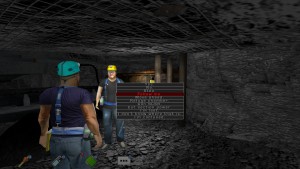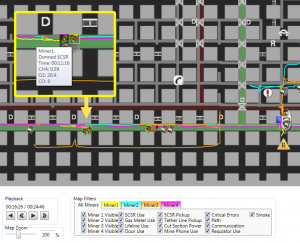NIOSH Mine Emergency Escape Simulation Technology Available for Developers
Posted on by
Background
All underground coal miners in the United States receive escape training on a quarterly basis. This training prepares them for exiting the mine in the event of an emergency and it must include walking either the primary or the secondary escape route from their work area to the outside (30 CFR, 2015). As a way to both study the mine emergency escape system and to supplement the existing training, NIOSH researchers developed the Mine Emergency Escape Training (or MEET) software. MEET uses a virtual immersive environment to create an underground coal mine escape experience focusing on knowledge of escape procedures while utilizing judgment and decision making skills. While NIOSH uses MEET as a research tool, others can use it in new miner, annual refresher, or emergency response training. MEET is appropriate for underground coal miners at any skill or experience level. NIOSH is offering the MEET software to developers interested in tailoring the training as well as to mine safety and health trainers, safety managers and others who can use it “out-of-the-box” for their training needs.
The software, already used to train over 1,000 miners, encourages participants to use critical thinking while escaping a virtual mine emergency. When used in a training scenario, the included instructor’s guide contains questions moderators can ask during the after-action debriefing to reinforce learning and stimulate discussion among participants about emergency evacuations. The software includes three distinct components:
- A pre-evacuation tutorial where users practice operating keyboard and mouse controls, interface with the simulation, and learn about tools available to aid their escape (Figure 1);
- The underground simulation where users start at predetermined locations in a virtual underground coal mine, and must evacuate to safety (Figure 2);
- A post-evacuation debriefing tool where the moderator reviews routes participants followed, actions they took, and decisions made.

Developed using the Unreal 2® game engine, MEET can operate in single player mode for display on a projector screen to a group of participants in a classroom, or multiplayer mode with up to four computers connected via a router for group sessions. Multiplayer mode allows more than one participant to join the virtual mine escape with each computer representing a different miner who must evacuate. Once underground, players can decide whether to work together to solve problems and make decisions during their evacuations or to evacuate on their own.
In the underground simulation participants are told of the discovery of smoke from an unknown source and that they must evacuate the mine. They must decide the course of action to successfully escape to safety. Based on information presented throughout the simulation, they decide their escape routes, when to change their route, when to don a self-contained self-rescuer, what to do when they encounter a roof fall in an escapeway, and whether they should retreat to the refuge chamber.
In the simulation participants have a variety of tools they can use to help in their escape including escapeway lifelines, self-contained self-rescuer caches, multigas meters, survey markers, and tether lines.

Following the underground simulation, the moderator may conduct a debriefing session. For each run of the simulation, the software records all actions taken by participants and can display a map in the debriefing tool (Figure 3) to review the escape routes and actions escapees took. The post-evacuation debriefing serves as the basis for discussing escapees decision making and getting participants to talk about their decisions. They also have the opportunity to share personal stories and learn from each other.
NIOSH researchers conducted field-testing of MEET as a training tool with a mining company during their annual fire prevention training. The study included 68 trainees. The average age of the trainees was 39 years and they averaged over 10 years of mining experience.
In a post-training feedback session, trainees reported that the simulation was relevant to their needs and was realistic. Trainees also felt that the MEET simulation has robust training value in improving their preparedness.
NIOSH is making the MEET software available, as is, for download by mine safety and health trainers, safety managers and others. Click here to access MEET . You will find links to the MEET software, a PDF of the instructor’s guide and mine map, and a tip sheet for users. Our hope is that the mining industry will find the training aspects of the MEET software useful in improving their workforce’s ability to handle mine emergency evacuations.
Timothy J. Orr
Mr. Orr is a computer engineer in the NIOSH Pittsburgh Mining Research Division.
Posted on by

